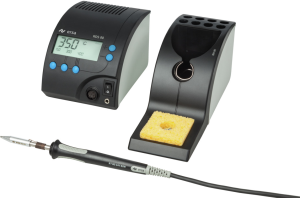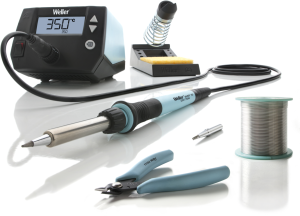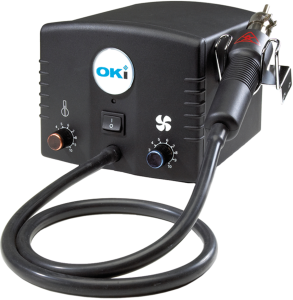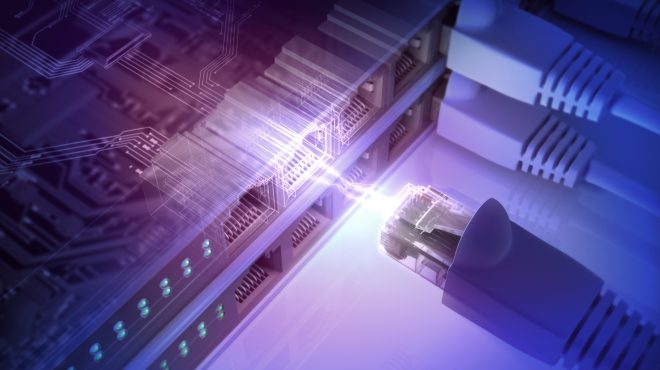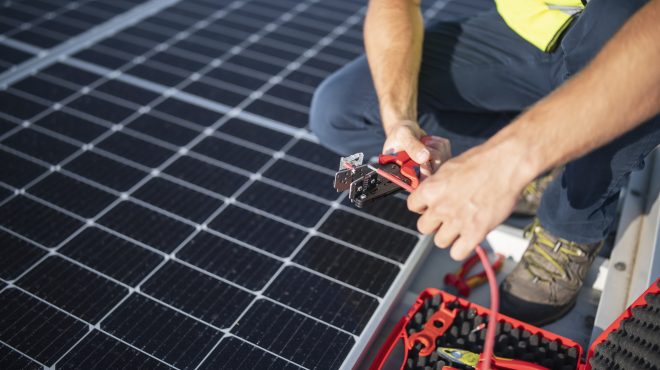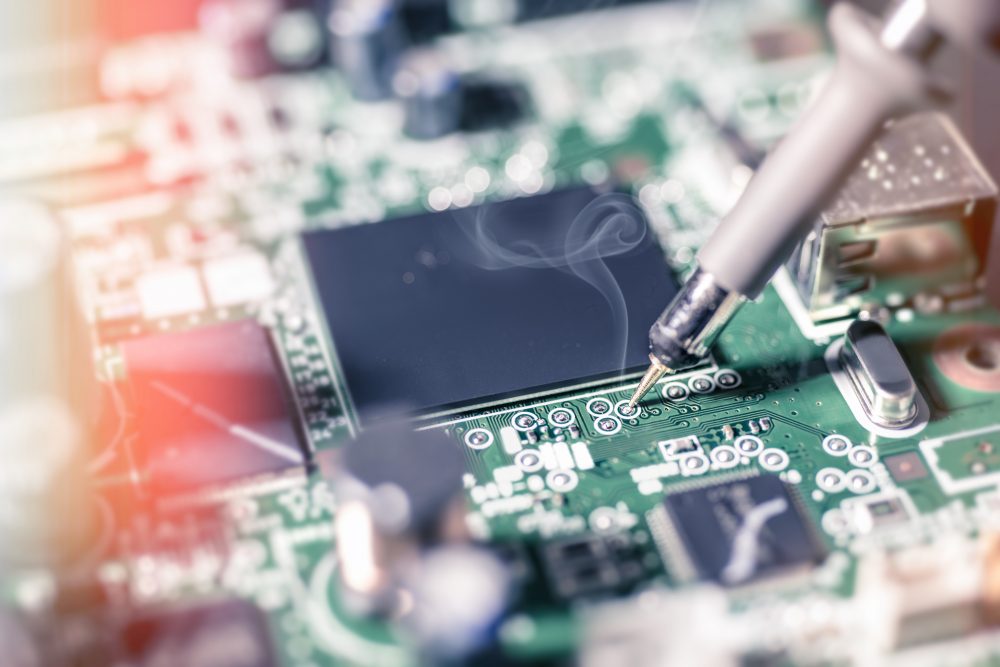
Soldering Stations Guide
A soldering station is a special version of a soldering iron. Soldering stations usually consist of three components: a power supply unit, the so-called soldering iron unit and the soldering iron. Before you buy a soldering station, you should think about modes of operation, specific characteristics and the different types, as well as necessary accessories. We have answered the most important questions and made specific recommendations on the subject of soldering stations.
Table of contents
- What are the advantages of soldering electrical components?
- How does a soldering station work?
- What soldering stations are available?
- Where are soldering stations used?
- What distinguishes a good soldering station?
- What advantages do soldering stations have over unregulated soldering irons?
- Accessories for soldering stations
What are the advantages of soldering electrical components?
- Lower heat input compared to welding
- joining of different materials
- less distortion
- good thermal conductivity
- good electrical conductivity
- permanently tight joints
- filigree parts can be soldered without damage
- no change of base materials due to low working temperature
It should be noted that soldering nevertheless has disadvantages. Welded seams, for example, are often much more stable in comparison. In addition, the surface to which the solder is applied must be carefully cleaned in advance.
High-quality special cleaners are ideal for removing industrial dust and other contaminants. Cleaning sticks also make it easier to reach the hard-to-reach components in the electronic device.
How does a soldering station work?
Temperature controlled soldering stations fall into the category of soldering irons. Other types include the soldering gun, the unregulated soldering iron and the soldering needle. In the electric soldering iron, the soldering tip, which is usually made of copper, is heated, either from the inside or from the outside. In the classic version, the heating element is usually located in the head area. The soldering iron is held by the handle provided for this purpose. As a rule, the soldering tip can be replaced depending on the area of application..
Soldering stations also have a temperature sensor in the immediate vicinity of the soldering tip. The sensor measures the degree and reports this back to the heating element of the soldering station, which then readjusts the temperature accordingly.
By the way: Soldering basically means that only the solder is melted to join parts together. In welding, on the other hand, the metals to be joined are also melted. A distinction is also made between soft soldering and hard soldering, whereby the melting temperature of the solder used, the so-called liquidus temperature, is decisive:
- up to 450 degrees Celsius: soft soldering
- between 450 and 900 degrees Celsius: brazing
- from 900 degrees Celsius: high temperature brazing or welding
All types of soldering irons listed above are suitable for soft soldering only.
What soldering stations are available?
Digital, analog and with hot air – this is how soldering stations are generally classified by type. But which soldering station is suitable for which application, and what distinguishes the three types?
Both digital and analog soldering stations are in use for electronic components such as circuit boards, chip cards or microcontrollers. The only difference is temperature control. Anyone working with SMD components (surface-mounted devices) is well advised to use hot air soldering stations.
- analog: Since the analog soldering station only has a rotary control, the exact degree is not known. If you want to work to the exact degree, you need a lot of intuition and some experience.
- Digital: With the digital soldering station, the temperature can be set precisely using knobs and shown on the display. As a result, the temperature remains constant both when working and during breaks.
- With hot air: So that sensitive SMD components do not suffer any damage, so-called hot air soldering stations are recommended, although they are expensive. Here, the solder is heated by means of a hot air nozzle. Either classic soldering iron or hot air nozzle? In the meantime, there are combination devices that are equipped with both functional mechanisms.
Good to know: Well-known manufacturers of high-quality soldering stations are Weller, Ersa and JBC.
Where are soldering stations used?
Soldering connects two electronic components intermetallically. This mode of action opens up a wide range of applications for soldering stations. In most cases, components are attached to circuit boards or printed circuit boards in this way.
But soldering is also a much-used technique in research and development. Prototypes can be built and improved quickly with its help – and are ready for testing or subsequent production steps within a very short time.
Soldering stations are also used in model making. Tinning flexible wires, wiring systems, creating electronic circuits, or building metal models: Every model builder knows how important a suitable soldering iron is for precise work.
As electronic components become smaller and boards become more closely packed, soldering operations become increasingly complex and complicated. For meaningful test results and efficient development processes, soldering stations must function accurately and reliably. Since electronic components are particularly sensitive, only soft soldering is usually used in this area.
Speaking of sensitive: The so-called SMD components are electronic components that are free of wire connections. They are attached directly to the circuit board by means of solderable connection pads, which requires a high degree of attentiveness and precision. In specialist circles, this technique is known as surface mounting.
With some soldering stations it is also possible to desolder components. However, this takes much longer and involves a lot of effort. In addition, the components are exposed to the heat of the soldering iron for longer, which increases the risk of damage.
What distinguishes a good soldering station?
Fast heating, safe shutdown, easy handling – when choosing a soldering station for professional use, it is important to consider some important features:
Easy handling
When is a soldering station easy to use? Certainly, the ideal soldering station is different for every need. Nevertheless, there are some basic things that simplify handling for every electronics engineer.
Battery-powered or mains powered? Both have their advantages and disadvantages. Battery-operated soldering stations can be used regardless of location, but only for a maximum period of one hour. Mains powered devices are less flexible in terms of location, but can be used without time restrictions.
An important aspect is also the distance between the handle and the tip of the soldering iron. A short distance enables precise work on boards that are closely mounted with resistors and transistors. For larger components that require a larger soldering tip, a soldering iron with a wider distance between handle and tip is recommended. After all, these soldering jobs require higher temperatures over a longer period of time.
Keep in mind: The thinner and lighter the cable between the soldering iron and the station, the more flexible the soldering tip can be guided – without changing the position of the entire station. Also helpful are an easy-to-read display and a function that allows multiple temperature units to be stored.
Last but not least, the soldering tip should always be adapted to the task at hand and therefore easy to change. Soldering stations usually include a soldering tip with a standard size of two millimeters in diameter. Overall, soldering tips with dimensions from 0.2 to 35 millimeters are available.
Other features of a good soldering station:
- Temperature: The required temperature depends on the melting range of the solder, but is usually between 150 and 450 degrees Celsius. The soldering tip is always slightly warmer than the set number of degrees to compensate for temperature losses. The less the temperature accuracy deviates, the better.
- Power Level: Power levels range from 10 to 900 watts and depend on the length of the heat-up time. For everyday electronic applications, 50 to 60 watts is sufficient.
- Heating time: The higher the power of the soldering iron, the faster it heats up. In other words, if you use the device frequently, you should go for a particularly powerful version.
- Stand-by function and automatic switch-off: For many applications, soldering stations that switch off automatically or switch to stand-by mode are recommended. In the latter case, the soldering tip is cooled down to 100 to 150 degrees, which reduces wear and saves energy at the same time.
- Extraction: Special filter systems are used to extract quality-reducing particles and gases – a mandatory component of commercial and industrial plants.
- Potential equalization: Potential equalization describes the sensitivity to static discharges. Many devices are equipped with a socket or connection for grounding.
- Air volume for soldering stations with hot air: If you work with hot air, you should pay attention to the maximum amount of air that is emitted per minute. If this figure is too high, components could fly off and be damaged. The air volume ranges from 2.5 to 120 liters per minute.
What advantages do soldering stations have over unregulated soldering irons?
Soldering stations are operated with an extra-low voltage that is isolated from the mains. This means that there is less risk of electronic components being damaged by static charges or leakage currents than with a soldering iron.
High-quality soldering stations also have a grounding option and are compatible with countless soldering tips and soldering inserts for a wide range of applications.
Compared with the unregulated variant, soldering station soldering irons are much more manageable – and with the same heating power. The cables are more flexible, as no mains voltage-proof cable is required.
The temperature control integrated in soldering stations enables fast heating with comparatively high power. Nevertheless, even very fine soldering tips can be used.
Speaking of soldering tips: These remain largely within the optimum temperature range even at high soldering frequency and during work breaks, which increases the quality of the solder joints. Our recommendation: Invest in quality products! Although these are more expensive to purchase, the spare parts for soldering stations from well-known manufacturers are still available even after several decades.
What soldering irons are available?
Soldering needles are small soldering irons that are suitable for fine work. The miniature soldering irons are used, for example, for soldering thin wires or for correcting and reworking SMD components. Soldering needles are often supplied with low voltage. This type of soldering iron is less suitable for applications in electrical engineering.
Fine soldering irons are lightweight soldering irons for assembling circuit boards or soldering and unsoldering thin wires and stranded wires. Electronics universal soldering irons are the standard devices for electronics engineers and are used for soldering circuit assemblies. Equipped with different soldering tips, soldering irons in this category are suitable for numerous areas of application.
Temperature-controlled soldering irons allow the temperature to be controlled as required. Especially when the soldering iron is used for a longer period of time or placed in the holder, the soldering tip can heat up too much. The powerful single-channel soldering station WT 1012 set from Weller is an efficient solution: If the soldering iron is not used for a longer period of time, the soldering station automatically switches to standby mode. This reduces energy consumption and wear on the soldering tips.
What types of soldering tips are available?
- Conical soldering tips: are particularly suitable for soldering joints in confined spaces.
- Wide and flat soldering tips: enable a larger or smaller contact on the electrical component to be soldered.
- Cylindrical / beveled soldering tips: offer a wide range of possibilities to heat the solder faster.
- Straight soldering tips: allow a “pencil”-like application of the soldering iron for precise positioning of the plunger on the solder.
In the field, in particular, it is advantageous to be able to use different soldering tips for different areas of application. To save time, it must be possible to change the needles quickly and easily. The soldering iron of the Weller WE 1010 soldering station (230 V) venables soldering tip replacement even when the tip is still hot and without additional tools.
Accessories for soldering stations
- Third hand as a stable and individually adjustable clamp connection: Thanks to the so-called crocodile clamps, both hands remain free to hold the soldering iron and solder.
- Soldering tip cleaner that removes flux and solder residues and simultaneously tins the soldering tip. Alternatively, a dry cleaner made from brass wool.
- Flux that flows into even the smallest openings. It ensures that components in the soldering process are really permanently joined together and do not just stick together.
- Soldering preheating plates heat the board from the underside, which lowers the required operating temperature of the soldering iron. This protects heat-sensitive components and thus prevents damage.
- Desoldering suction pumps and desoldering braids are proven aids when replacing components. Helpful for picking up excess solder, although more expensive, is an electric pump that enables clean work.

